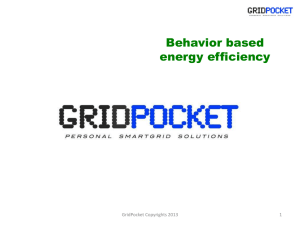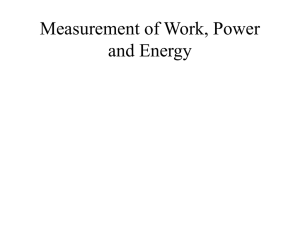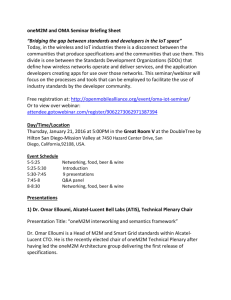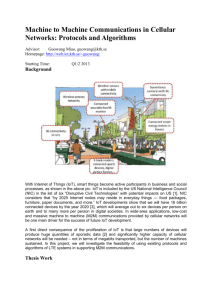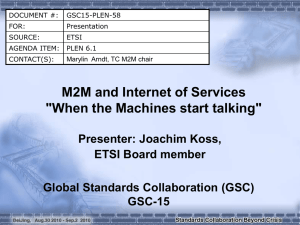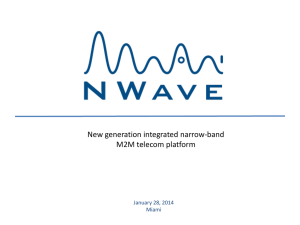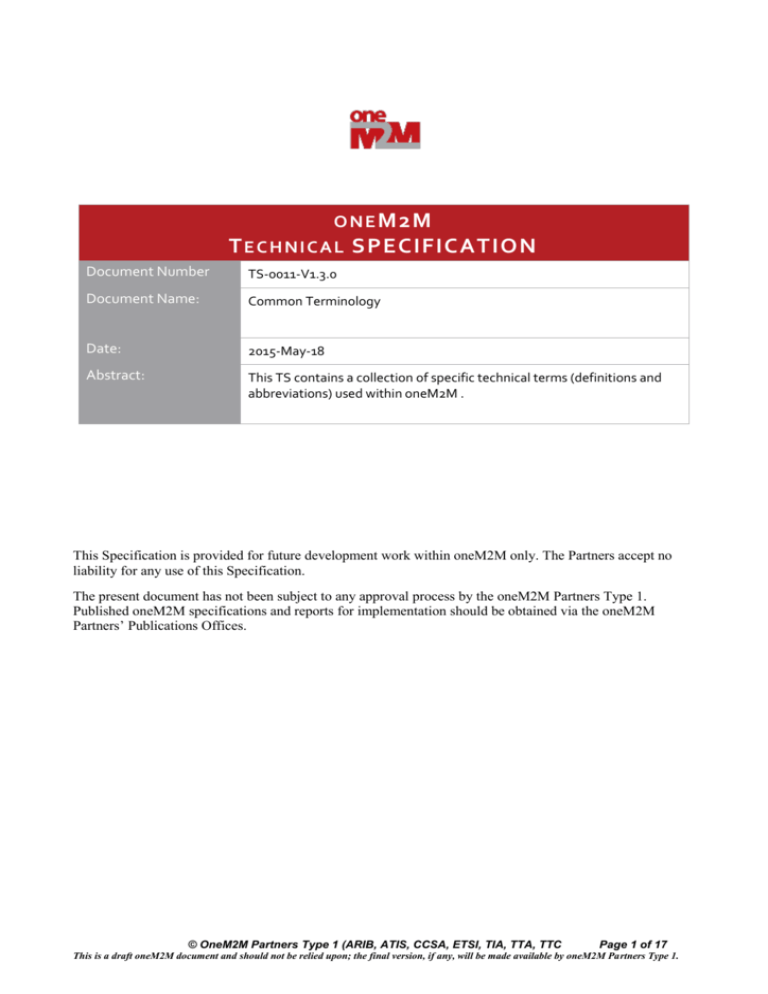
O NE M2M
T EC H NI C A L SPECIFICATION
Document Number
TS-0011-V1.3.0
Document Name:
Common Terminology
Date:
2015-May-18
Abstract:
This TS contains a collection of specific technical terms (definitions and
abbreviations) used within oneM2M .
This Specification is provided for future development work within oneM2M only. The Partners accept no
liability for any use of this Specification.
The present document has not been subject to any approval process by the oneM2M Partners Type 1.
Published oneM2M specifications and reports for implementation should be obtained via the oneM2M
Partners’ Publications Offices.
© OneM2M Partners Type 1 (ARIB, ATIS, CCSA, ETSI, TIA, TTA, TTC
Page 1 of 17
This is a draft oneM2M document and should not be relied upon; the final version, if any, will be made available by oneM2M Partners Type 1.
About oneM2M
The purpose and goal of oneM2M is to develop technical specifications which address the
need for a common M2M Service Layer that can be readily embedded within various
hardware and software, and relied upon to connect the myriad of devices in the field with
M2M application servers worldwide.
More information about oneM2M may be found at: http//www.oneM2M.org
Copyright Notification
No part of this document may be reproduced, in an electronic retrieval system or otherwise,
except as authorized by written permission.
The copyright and the foregoing restriction extend to reproduction in all media.
© 2015, oneM2M Partners Type 1 (ARIB, ATIS, CCSA, ETSI, TIA, TTA, TTC).
All rights reserved.
Notice of Disclaimer & Limitation of Liability
The information provided in this document is directed solely to professionals who have the
appropriate degree of experience to understand and interpret its contents in accordance with
generally accepted engineering or other professional standards and applicable regulations.
No recommendation as to products or vendors is made or should be implied.
NO REPRESENTATION OR WARRANTY IS MADE THAT THE INFORMATION IS
TECHNICALLY ACCURATE OR SUFFICIENT OR CONFORMS TO ANY STATUTE,
GOVERNMENTAL RULE OR REGULATION, AND FURTHER, NO
REPRESENTATION OR WARRANTY IS MADE OF MERCHANTABILITY OR
FITNESS FOR ANY PARTICULAR PURPOSE OR AGAINST INFRINGEMENT OF
INTELLECTUAL PROPERTY RIGHTS. NO oneM2M PARTNER TYPE 1 SHALL BE
LIABLE, BEYOND THE AMOUNT OF ANY SUM RECEIVED IN PAYMENT BY
THAT PARTNER FOR THIS DOCUMENT, WITH RESPECT TO ANY CLAIM, AND IN
NO EVENT SHALL oneM2M BE LIABLE FOR LOST PROFITS OR OTHER
INCIDENTAL OR CONSEQUENTIAL DAMAGES. oneM2M EXPRESSLY ADVISES
ANY AND ALL USE OF OR RELIANCE UPON THIS INFORMATION PROVIDED IN
THIS DOCUMENT IS AT THE RISK OF THE USER.
© OneM2M Partners Type 1 (ARIB, ATIS, CCSA, ETSI, TIA, TTA, TTC
Page 2 of 17
This is a draft oneM2M document and should not be relied upon; the final version, if any, will be made available by oneM2M Partners Type 1.
Contents
1
Scope ........................................................................................................................................................ 5
2
References ................................................................................................................................................ 5
2.1
2.2
3
3.0
3.1
3.2
3.3
3.4
3.5
3.6
3.7
3.8
3.9
3.10
3.11
3.12
3.13
3.14
3.15
3.16
3.17
3.18
3.19
3.20
3.21
3.22
3.23
3.24
3.25
3.26
3.27
4
4.1
4.2
4.3
4.4
4.5
4.6
4.7
4.8
4.9
4.10
4.11
4.12
4.13
4.14
4.15
4.16
4.17
4.18
4.19
4.20
4.21
Normative references ......................................................................................................................................... 5
Informative references ....................................................................................................................................... 5
Definitions ................................................................................................................................................ 6
General Information ........................................................................................................................................... 6
0-9 ...................................................................................................................................................................... 6
A ........................................................................................................................................................................ 6
B ........................................................................................................................................................................ 7
C ........................................................................................................................................................................ 7
D ........................................................................................................................................................................ 8
E ......................................................................................................................................................................... 8
F ......................................................................................................................................................................... 8
G ........................................................................................................................................................................ 8
H ........................................................................................................................................................................ 8
I .......................................................................................................................................................................... 9
J.......................................................................................................................................................................... 9
K ........................................................................................................................................................................ 9
L ......................................................................................................................................................................... 9
M........................................................................................................................................................................ 9
N ...................................................................................................................................................................... 10
O ...................................................................................................................................................................... 10
P ....................................................................................................................................................................... 10
Q ...................................................................................................................................................................... 10
R ...................................................................................................................................................................... 10
S ....................................................................................................................................................................... 10
T ....................................................................................................................................................................... 12
U ...................................................................................................................................................................... 12
V ...................................................................................................................................................................... 12
W ..................................................................................................................................................................... 12
X ...................................................................................................................................................................... 12
Y ...................................................................................................................................................................... 12
Z ....................................................................................................................................................................... 12
Abbreviations ......................................................................................................................................... 12
0-9 .................................................................................................................................................................... 12
A ...................................................................................................................................................................... 13
B ...................................................................................................................................................................... 13
C ...................................................................................................................................................................... 13
D ...................................................................................................................................................................... 13
E ....................................................................................................................................................................... 13
F ....................................................................................................................................................................... 13
G ...................................................................................................................................................................... 13
H ...................................................................................................................................................................... 13
I ........................................................................................................................................................................ 13
J........................................................................................................................................................................ 13
K ...................................................................................................................................................................... 14
L ....................................................................................................................................................................... 14
M...................................................................................................................................................................... 14
N ...................................................................................................................................................................... 14
O ...................................................................................................................................................................... 14
P ....................................................................................................................................................................... 14
Q ...................................................................................................................................................................... 14
R ...................................................................................................................................................................... 14
S ....................................................................................................................................................................... 14
T ....................................................................................................................................................................... 14
© OneM2M Partners Type 1 (ARIB, ATIS, CCSA, ETSI, TIA, TTA, TTC
Page 3 of 17
This is a draft oneM2M document and should not be relied upon; the final version, if any, will be made available by oneM2M Partners Type 1.
4.22
4.23
4.24
4.25
4.26
4.27
U ...................................................................................................................................................................... 14
V ...................................................................................................................................................................... 15
W ..................................................................................................................................................................... 15
X ...................................................................................................................................................................... 15
Y ...................................................................................................................................................................... 15
Z ....................................................................................................................................................................... 15
Annex A (informative): Bibliography ........................................................................................................... 16
History .............................................................................................................................................................. 17
© OneM2M Partners Type 1 (ARIB, ATIS, CCSA, ETSI, TIA, TTA, TTC
Page 4 of 17
This is a draft oneM2M document and should not be relied upon; the final version, if any, will be made available by oneM2M Partners Type 1.
1
Scope
The present document contains a collection of specialist technical terms, definitions and abbreviations referenced within
the oneM2M specifications.
Having a common collection of definitions and abbreviations related to oneM2M documents will:
ensure that the terminology is used in a consistent manner across oneM2M documents;
provide a reader with convenient reference for technical terms that are used across multiple documents.
The present document provides a tool for further work on oneM2M technical documentation and facilitates their
understanding. The definitions and abbreviations as given in the present document are either externally created and
included here, or created internally within oneM2M by the oneM2M TP or its working groups, whenever the need for
precise vocabulary is identified or imported from existing documentation.
In addition in oneM2M Technical Specifications and Technical Reports there are also clauses dedicated for locally
unique definitions and abbreviations.
2
References
2.1
Normative references
References are either specific (identified by date of publication and/or edition number or version number) or
non-specific. For specific references, only the cited version applies. For non-specific references, the latest version of the
reference document (including any amendments) applies.
The following referenced documents are necessary for the application of the present document.
Not applicable.
2.2
Informative references
References are either specific (identified by date of publication and/or edition number or version number) or
non-specific. For specific references, only the cited version applies. For non-specific references, the latest version of the
reference document (including any amendments) applies.
The following referenced documents are not necessary for the application of the present document but they assist the
user with regard to a particular subject area.
[i.1]
Recommendation ITU-T X.800 (1991): “Security architecture for open system interconnection for
CCIT applications”.
[i.2]
Recommendation ITU-T X.800/Amd.1 (1996): “Security architecture for open systems
interconnection for CCITT applications. Amendment 1: Layer Two Security Service and
Mechanisms for LANs”.
[i.3]
ISO/IEC 27001 (2005): “Information technology – Security techniques – Information security
management systems – Requirements”.
[i.4]
ISO/IEC 27002 (2005): “Information technology – Security techniques – Code of practice for
information security management”.
[i.5]
IETF RFC 4949 (2007): “Internet Security Glossary, Version 2”.
[i.6]
NIST SP800-57 Part 1 (07/2012): “Recommendation for Key Management – General, Rev3”.
[i.7]
NIST SP800-57 Part 1 (05/2011): “Recommendation for Key Management – General, Rev3”.
© OneM2M Partners Type 1 (ARIB, ATIS, CCSA, ETSI, TIA, TTA, TTC
Page 5 of 17
This is a draft oneM2M document and should not be relied upon; the final version, if any, will be made available by oneM2M Partners Type 1.
[i.8]
ISO/IEC 13888-1 (07/2009 – 3rd ed) Information technology – Security techniques – Nonrepudiation – Part 1: General”.
[i.9]
ISO/IEC 24760-1 (12/2011 – 1st edition): “Information technology – Security techniques – A
framework for identity management – Part 1: terminology and concepts”.
[i.10]
ISO/IEC 27004 (12/2009 – 1st edition): “Information technology – Security techniques –
Information security management – Measurement”.
[i.11]
ISO/IEC 9798-1 (07/2010 – 3rd edition): “Information technology – Security techniques – Entity
authentication -. Part 1: General”.
[i.12]
ISO/IEC TR 15443-1:2012: “Information technology – Security techniques – Security assurance
framework – Part 1: Introduction and concepts”.
[i.13]
IEEE 802.15.4TM-2003: “IEEE Standard for Local and metropolitan area networks –
Part 15.4: Low-Rate Wireless Personal Area Networks (LR-WPANs)”.
[i.14]
OMA OMA-TS-LightweightM2M-V1_0-20141111-D: "Lightweight Machine to Machine
Technical Specification".
3
Definitions
3.0
General Information
NOTE 1: Whenever in the present document a term “M2M Xyz” (e.g. M2M Application, M2M Solution, etc.) is
used, then the prefix “M2M” should indicate that – unless otherwise indicated – the term identifies an
entity Xyz that complies with oneM2M specifications.
NOTE 2: For better readability of the present document the prefix “M2M” is ignored when definitions are
alphabetically ordered.
3.1
0-9
Void.
3.2
A
abstract information model: information Mmdel of common functionalities abstracted from a set of Device
Information Models
abstraction: process of mapping between a set of Device Information Models and an Abstract Information Model
according to a specified set of rules
access control attributes: set of parameters of the originator, target resource, and environment against which there
could be rules evaluated to control access
NOTE:
An example of Access Control Attributes of Originator is a role. Examples of Access Control Attributes
of Environment are time, day and IP address. An example of Access Control Attributes of targeted
resource is creation time.
access control policy: set of privileges which represents access control rules defining allowed entities for certain
operations within specified contexts that each entity has to comply with to grant access to an object
access control role: security attribute associated to an entity defining the entity’s access rights or limitations to allowed
operations
NOTE:
One or more operations can be associated to an Access Control Role. An Access Control Role can be
associated to one or more entities and an entity can assume one or more Access Control Roles.
© OneM2M Partners Type 1 (ARIB, ATIS, CCSA, ETSI, TIA, TTA, TTC
Page 6 of 17
This is a draft oneM2M document and should not be relied upon; the final version, if any, will be made available by oneM2M Partners Type 1.
access decision: authorization reached when an entity’s Privileges are evaluated
analytics: processing which makes use of data to provide actions, insights and/or inference
M2M application: applications that run the service logic and use M2M Common Services accessible via a set of
oneM2M specified open interfaces
NOTE:
Specification of M2M Applications is not subject of the current oneM2M specifications.
M2M area network: is a form of an Underlying Network that minimally provides data transport services among M2M
Gateway(s), M2M Device(s), and Sensing&Actuation Equipment. M2M Local Area Networks can use heterogeneous
network technologies that may or may not support IP access
NOTE:
An M2M Area Network technology is characterized by its physical properties (e.g. IEEE 802.15.4-2003
[i.13] 2_4GHz), its communication protocol (e.g. ZigBee_1_0) and potentially a profile (e.g.
ZigBee_HA).
application dedicated node: is a Node that contains at least one Application Entity and does not contain a Common
Services Entity
NOTE:
There may be zero or more ADNs in the Field Domain of the oneM2M System.
EXAMPLE:
Physical mapping: an Application Dedicated Node could reside in a constrained M2M Device.
application entity: represents an instantiation of Application logic for end-to-end M2M solutions.
M2M application infrastructure: equipment (e.g. a set of physical servers of the M2M Application Service Provider)
that manages data and executes coordination functions of M2M Application Services
NOTE:
The Application Infrastructure hosts one or more M2M Applications. Specification of Application
Infrastructure is not subject of the current oneM2M specifications.
M2M application service: realized through the service logic of an M2M Application and is operated by the User or an
M2M Application Service Provider
application service node: is a Node that contains one Common Services Entity and contains at least one Application
Entity
NOTE:
There may be zero or more ASNs in the Field Domain of the oneM2M System.
EXAMPLE:
Physical mapping: an Application Service Node could reside in an M2M Device.
M2M application service provider: is an entity (e.g. a company) that provides M2M Application Services to the User
authentication [i.7]: process that establishes the source of information, or determines an entity’s identity
authorization [i.1]: granting of rights, which includes the granting of access based on access rights
3.3
B
Void.
3.4
C
M2M common services: is the set of oneM2M specified functionalities that are widely applicable to different
application domains made available through the set of oneM2M specified interfaces
common services entity: represents an instantiation of a set of Common Service Functions of the M2M environments.
Such service functions are exposed to other entities through reference points
common services function: is an informative architectural construct which conceptually groups together a number of
sub-functions
© OneM2M Partners Type 1 (ARIB, ATIS, CCSA, ETSI, TIA, TTA, TTC
Page 7 of 17
This is a draft oneM2M document and should not be relied upon; the final version, if any, will be made available by oneM2M Partners Type 1.
NOTE:
Those sub-functions are implemented as normative resources and procedures. A set of CSFs is contained
in the CSE.
confidentiality [i.1]: property that information is not made available or disclosed to unauthorized individuals, entities,
or processes
credentials: data objects which are used to uniquely identify an entity and which are used in security procedures.
credential-ID: A globally unique identifier for a credential that was used to establish a security association between
entities (CSEs and/or AEs).
NOTE:
3.5
The Credential-ID can be used to determine the identifying information about the authenticated entity,
such as the CSE-ID or AE-ID(s) or App-ID(s).
D
data: in the context of oneM2M the term “Data” signifies digital representations of anything
NOTE:
Data can or cannot be interpreted by the oneM2M System and/or by M2M Applications. See also
Information.
M2M device: physical equipment with communication capabilities, providing computing and/or sensing and/or
actuation services
NOTE:
An M2M Device hosts one or more M2M Applications or other applications and can contain
implementations of CSE functionalities.
EXAMPLE:
Physical mapping: A M2M Device contains an Application Service Node or an Application
Dedicated Node.
device information model: Information Model of the native protocol (e.g. ZigBee) for the physical device
dynamic device/gateway context: dynamic metrics, which may impact the M2M operations of M2M
Devices/Gateways
3.6
E
encryption [i.6]: process of changing plaintext into ciphertext using a cryptographic algorithm and key
event: interaction or occurrence related to and detected by the oneM2M System
event categories: set of indicators that specify the treatment of Events for differentiated handling, based on policies
3.7
F
field domain: consists of M2M Devices, M2M Gateways, Sensing and Actuation (S&A) Equipment and M2M Area
Networks
3.8
G
M2M gateway: physical equipment that includes, at minimum, the entities and APIs of a Middle Node
3.9
H
Void.
© OneM2M Partners Type 1 (ARIB, ATIS, CCSA, ETSI, TIA, TTA, TTC
Page 8 of 17
This is a draft oneM2M document and should not be relied upon; the final version, if any, will be made available by oneM2M Partners Type 1.
3.10
I
identification [i.9]: process of recognizing an entity in a particular domain as distinct from other entities
NOTE 1: The process of identification applies verification to claimed or observed attributes.
NOTE 2: Identification typically is part of the interactions between an entity and the services in a domain and to
access resources. Identification may occur multiple times while the entity is known in the domain.
information: in the context of oneM2M “Information”signifies data that can be interpreted by the oneM2M System
NOTE:
Information has a defined syntax and semantic within the oneM2M System. See also Data.
information model: abstract, formal representation of entities that may include their properties, relationships and the
operations that can be performed on them
infrastructure domain: consists of Application Infrastructure and M2M Service Infrastructure
infrastructure node: is a Node that contains one Common Services Entity and contains zero or more Application
Entities
NOTE:
There is exactly one Infrastructure Node in the Infrastructure Domain per oneM2M Service Provider.
EXAMPLE:
Physical mapping: an Infrastructure Node could reside in an M2M Service Infrastructure.
integrity [i.3], [i.4]: safeguarding the accuracy and completeness of information and processing methods
3.11
J
Void.
3.12
K
key [i.6]: parameter used in conjunction with a cryptographic algorithm that determines its operation in such a way that
an entity with knowledge of the key can reproduce or reverse the operation, while an entity without knowledge of the
key cannot
3.13
L
LWM2M client [i.14]: application that manages and controls things that are represented as LWM2M objects.
LWM2M client endpoint name [i.14]: the identifier for a LWM2M client.
LWM2M object [i.14]: the LWM2M representation of a thing. LWM2M objects are identified through a URI.
LWM2M server [i.14]: application that manages and controls LWM2M clients.
3.14
M
middle node: is a Node that contains one Common Services Entity and contains zero or more Application Entities
NOTE 1: There may be zero or more Middle Nodes in the Field Domain of the oneM2M System.
NOTE 2: The CSE in a Middle Node communicates with one CSE residing in a Middle Node or in an Infrastructure
Node and with one or more other CSEs residing in Middle Nodes or in Application Service Nodes. In
addition, the CSE in the Middle Node can communicate with AEs residing in the same MN or residing in
an ADN.
EXAMPLE:
Physical mapping: a Middle Node could reside in an M2M Gateway.
mutual authentication [i.11]: entity authentication that provides both entities with assurance of each other’s identity
© OneM2M Partners Type 1 (ARIB, ATIS, CCSA, ETSI, TIA, TTA, TTC
Page 9 of 17
This is a draft oneM2M document and should not be relied upon; the final version, if any, will be made available by oneM2M Partners Type 1.
3.15
N
network operator: is an entity (e.g. a company) that operates an Underlying Network
node: logical entity that is identifiable in the oneM2M System
3.16
O
oneM2M system: system developed by the oneM2M global initiative that enables deployable M2M Solutions
3.17
P
privacy [i.2]: right of individuals to control or influence what information related to them may be collected and stored
and by whom and to whom that information may be disclosed
privilege: qualification given to an entity that allows a specific operation (e.g. Create/Retreive/Update/Delete, etc.) on a
specific resource within a specified context
3.18
Q
Void.
3.19
R
remote security provisioning: The process of providing a credential into a secure environment of a Node deployed in
the field.
repudiation: denial by an entity of a claimed event or action
NOTE:
This definition applies to the security context only.
role-based access control [i.3]: permissions attributed to an Access Control Role granting access to an object
3.20
S
secure [i.12]: not vulnerable to most attacks, are able to tolerate many of the attacks that they are vulnerable to, and that
can recover quickly with a minimum of damage from the few attacks that successfully exploit their vulnerabilities
security [i.5]: system condition that results from the establishment and maintenance of measures to protect the system
security association: a set of shared security attributes necessary to perform secure communication between two
entities (CSEs and/or AEs) which have performed mutual authentication.
NOTE:
The security attributes include a description of the algorithms to be applied, and derived keys which are
applied for the lifetime of the security association.
security association establishment: a procedure for establishing a Security Association between two entities (CSEs
and/or AEs).
security pre-provisioning: The process of providing a credential into a secure environment of the Node prior to device
deployment, e.g. during manufacturing
security provisioning: process of configuring a credential into a secure environment of a Node to enable access to a
service provided by a target entity, such as communication services or M2M Services
NOTE:
This involves putting in the device and target entity the security Credentials that will be used for Mutual
Authentication.
© OneM2M Partners Type 1 (ARIB, ATIS, CCSA, ETSI, TIA, TTA, TTC
Page 10 of 17
This is a draft oneM2M document and should not be relied upon; the final version, if any, will be made available by oneM2M Partners Type 1.
Sensing and Actuation (S&A) equipment: equipment that provides functionality for sensing and/or influencing the
physical environment by interacting with one or more M2M Application Services
NOTE:
Sensing and Actuation Equipment can interact with the oneM2M System, however does not host an M2M
Application. The specification of S&A Equipment is not considered in the current oneM2M
specifications. S&A Equipment may, but does not need to, be co-located with an M2M Device.
sensitive data: is a classification of stakeholder’s data that is likely to cause its owner some adverse impact if either:
It becomes known to others when not intended.
It is modified without consent of the affected stakeholder.
M2M service: consists of one or more M2M Application Services and one or more M2M Common Services
M2M service administrative state of a M2M device: indicates whether the M2M Service is enabled by the M2M
Service Provider to be run for this device
M2M service infrastructure: physical equipment (e.g. a set of physical servers) that provides management of data and
coordination capabilities for the M2M Service Provider and communicates with M2M Devices
NOTE:
An M2M Service Infrastructure may communicate with other M2M Service Infrastructures. An M2M
Service Infrastructure contains a CSE. It can also contain M2M applications.
M2M service operational status of a M2M device: indicates whether the M2M Service is currently running for this
device
M2M service provider: is an entity (e.g. a company) that provides M2M Common Services to a M2M Application
Service Provider or to the User
M2M service subscriber: one of the M2M Stakeholders that subscribes to M2M Service(s)
M2M service subscription: agreement between a provider and a subscriber for consumption of M2M Services for a
period of time
NOTE:
An M2M Service Subscription is typically a commercial agreement.
M2M session: service layer communication relationship between endpoints managed via M2M Common Services
consisting of session authentication, connection establishment/termination, transmission of information and
establishment/termination of Underlying Network services
M2M solution: set of deployed systems satisfying all of the following criteria:
1)
it satisfies the end-to-end M2M communication requirements of particular users; and
2)
some part of the M2M Solution is realized by including services compliant to oneM2M specifications.
M2M stakeholder: entities who facilitate and/or participate in the legitimate operation of the oneM2M system
NOTE:
Examples of stakeholders, in alphabetical order, are:
M2M Application Service Provider;
Manufacturer of M2M Devices and/or M2M Gateways;
Manufacturer of oneM2M system and its components;
M2M Device/Gateway Management entities;
M2M Service Provider; Network Operator;
User/Consumer of the M2M solution;
etc.
static device/gateway context: static metrics, which may impact the M2M operations of M2M Devices/Gateways
© OneM2M Partners Type 1 (ARIB, ATIS, CCSA, ETSI, TIA, TTA, TTC
Page 11 of 17
This is a draft oneM2M document and should not be relied upon; the final version, if any, will be made available by oneM2M Partners Type 1.
3.21
T
thing: element which is individually identifiable in the oneM2M system
trust [i.8]: relationship between two elements, a set of activities and a security policy in which element x trusts element
y if and only if x has confidence that y will behave in a well defined way (with respect to the activities) that does not
violate the given security policy
3.22
U
underlying network: functions, networks, busses and other technology assisting in data transportconnectivity services
user: entity which utilizes the services of the M2M Solution
NOTE:
3.23
The User may or may not be a subscriber to an M2M Application Service or an M2M Service. The User
may or may not be identifiable in the oneM2M System.
V
verification [i.10]: confirmation, through the provision of objective evidence, that specified requirements have been
fulfilled
virtual device: logical device (implemented as software) that acts similar to physical M2M device and provides derived
data
EXAMPLE:
3.24
Average temperature of a room, number of vehicles that passed during the last minute.
W
Void.
3.25
X
Void.
3.26
Y
Void.
3.27
Z
Void.
4
Abbreviations
4.1
0-9
3GPP
3rd Generation Partnership Project
© OneM2M Partners Type 1 (ARIB, ATIS, CCSA, ETSI, TIA, TTA, TTC
Page 12 of 17
This is a draft oneM2M document and should not be relied upon; the final version, if any, will be made available by oneM2M Partners Type 1.
4.2
A
ACL
ADN
AE
API
ASN
4.3
Access Control List
Application Dedicated Node
Application Entity
Application Programming Interface
Application Service Node
B
BBF
4.4
Broad Band Forum
C
CHA
CPU
CSE
CSF
4.5
Continua Health Alliance
Centralized Processing Unit
Common Services Entity
Common Services Function
D
DM
4.6
Device Management
E
Void.
4.7
F
Void.
4.8
G
GBA
GSM
GSMA
4.9
Generic Bootstrapping Architecture
Global System for Mobile communications
GSM Association
H
Void.
4.10
I
IN
IP
4.11
Infrastructure Node
Internet Protocol
J
Void.
© OneM2M Partners Type 1 (ARIB, ATIS, CCSA, ETSI, TIA, TTA, TTC
Page 13 of 17
This is a draft oneM2M document and should not be relied upon; the final version, if any, will be made available by oneM2M Partners Type 1.
4.12
K
Void.
4.13
L
LWM2M
4.14
Lightweight M2M.
M
M2M
MN
MSISDN
MTC
4.15
Machine to Machine
Middle Node
Mobile Subscriber Integrated Services Digital Network-Number
Machine Type Communications
N
NSE
4.16
Network Service Entity
O
OMA
4.17
Open Mobile Alliance
P
Void.
4.18
Q
QoS
4.19
Quality of Service
R
RBAC…Role-Based Access Control
4.20
S
S&A
SDO
SMS
4.21
Sensing and Actuation
Standards Developing Organization
Short Message Service
T
TR
TS
4.22
UICC
USIM
USSD
URI
Technical Report
Technical Specification
U
Universal Integrated Circuit Card
Universal Subscriber Identity Module
Unstructured Supplementary Service Data
Universal Resource Identifier
© OneM2M Partners Type 1 (ARIB, ATIS, CCSA, ETSI, TIA, TTA, TTC
Page 14 of 17
This is a draft oneM2M document and should not be relied upon; the final version, if any, will be made available by oneM2M Partners Type 1.
4.23
V
Void.
4.24
W
WAN
4.25
Wide Area Network
X
Void.
4.26
Y
Void.
4.27
Z
Void.
© OneM2M Partners Type 1 (ARIB, ATIS, CCSA, ETSI, TIA, TTA, TTC
Page 15 of 17
This is a draft oneM2M document and should not be relied upon; the final version, if any, will be made available by oneM2M Partners Type 1.
Annex A (informative):
Bibliography
TR-0005: “Roles and Focus Areas”.
© OneM2M Partners Type 1 (ARIB, ATIS, CCSA, ETSI, TIA, TTA, TTC
Page 16 of 17
This is a draft oneM2M document and should not be relied upon; the final version, if any, will be made available by oneM2M Partners Type 1.
History
Publication history
V1.2.1
30 Jan 2015
Release 1 - Publication
Draft history (to be removed on publication)
V1.3.0
18 May 2015
incorporated the following CR:
REQ-2015-0539-LWM2M_Terminology in TP-2015-0692-CR_Pack_TS0011_Release_1.
© OneM2M Partners Type 1 (ARIB, ATIS, CCSA, ETSI, TIA, TTA, TTC
Page 17 of 17
This is a draft oneM2M document and should not be relied upon; the final version, if any, will be made available by oneM2M Partners Type 1.




